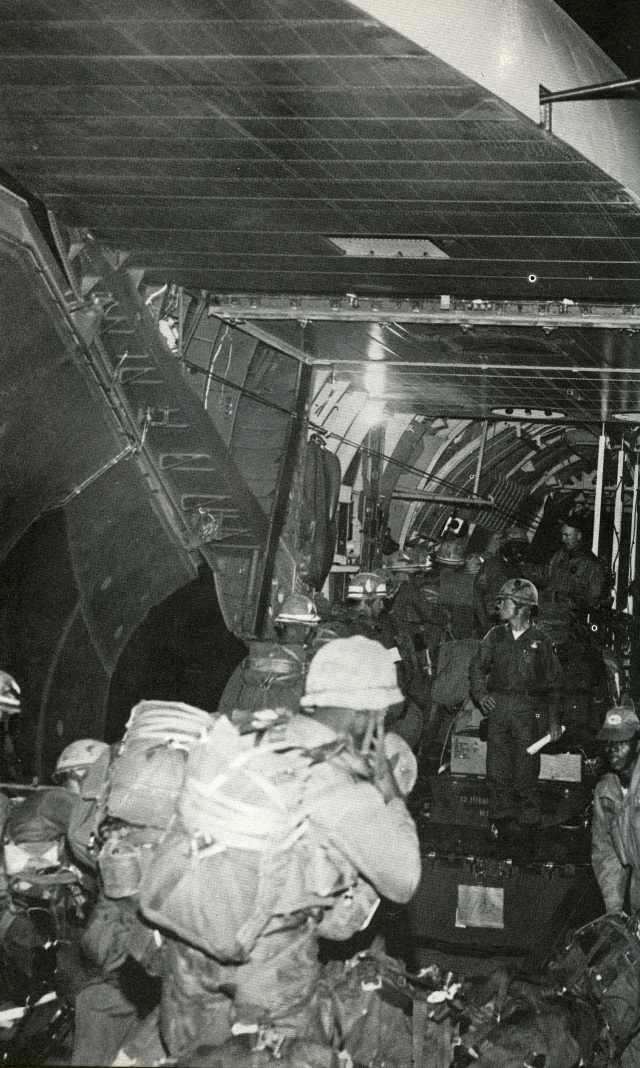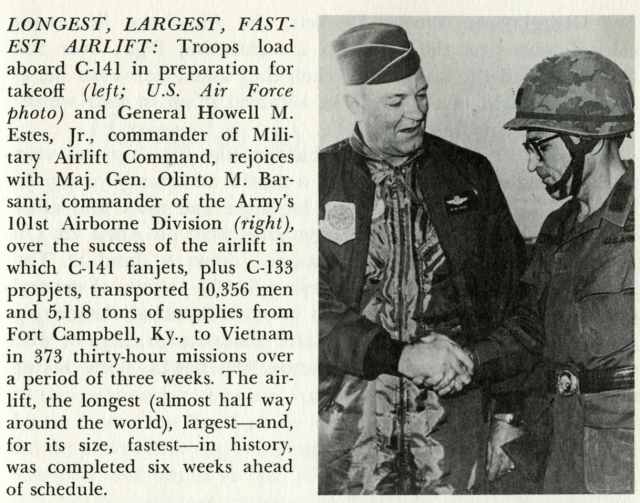StarLifter
The C-141, Lockheed's High Speed Flying Truck
by Harold H. Martin
"Go" in All Weathers
CHUCK WAGNER wasn't joking when he told his people, on the day of the StarLifter's first flight that they could celebrate for ten minutes, then they'd have to get back to work turning out airplanes. In the months that followed, the big planes came off the assembly line like apples rolling out of a barrel. By early June seven were in the air, the seventh flying to Eglin Air Force Base in Florida for cold-soaking in the huge test laboratory there. Later it was flown from Panama to the North Pole, to prove that its systems were go in all weathers. In mid-June the No. 6 plane made the first continent-spanning flight from Dobbins at Marietta, Georgia, to the Air Force Flight Test Center at Edwards Air Force Base in California. Major Joe Schiele was the aircraft commander, with Captain William P. Loewe as his copilot, and perched proudly on the jump seat between them was Lockheed-Georgia's Vice-President, Chuck Wagner, going along to see how well his baby behaved.
It behaved fine. Less than two hours after touchdown at Edwards the plane was aloft again on its first test mission, with General Irving L. Branch, commander of the flight test center, at the controls. The plane, in fact, turned out to be a pet of the high brass. Before it finished its test, fourteen generals had flown it.
By the time the first eight planes were in the air the StarLifter was as familiar to the Air Force pilots as it was to Leo Sullivan and his Lockheed test crew. Long before the roll-out of the first plane, a cadre of military pilots and engineers, under Lieutenant Colonel Joe Marlin, had come to Marietta for training by their Lockheed counterparts. No Air Force people were aboard on the first three flights, but after that, testing was carried out on a joint basis. Major Tommie Benefield was the first Air Force pilot to check out on the StarLifter, riding the flight deck on the fourth flight. Thereafter, he and Lieutenant Thomas McCabe, a test-flight engineer, stayed with the first plane throughout its initial testing.
For Chuck Wagner it was a proud moment when an all-Air Force test team first took over and flew his plane. "We put down at Edwards after a nice leisurely flight across country," he says. "It took about seven hours, for we didn't fly very high. And we hadn't been on the ground more than an hour before Joe Mar-lin's test people out there said, 'OK, let's go out and do our first mission with this airplane.' It started out that fast! They were like kids with new bikes at Christmas. They couldn't wait to get their hands on it. General Branch didn't have much to say when he landed after this first flight. But I knew, and I knew he knew-that we had built a good airplane."
Just how good was revealed, bit by bit, over the next twelve months. A test program was set up under which the plane would be flown a minimum of one thousand hours in the year. The aircraft, now known, curiously, as Petunia Pig, flew twenty-five hundred hours in eleven months, with a minimum of downtime for repair. It made one endurance flight of eighteen hours and twenty minutes. It flew a nonstop round-trip flight from Edwards to Honolulu, a distance of 4450 miles, checking out its navigational instruments, and it made another nonstop ran of 5600 miles. Its test period proved to be a great boon to Chuck Wagner and Max Hammond back in Georgia.
"Pretty soon we had five planes out there at Edwards, and a lot of parts and things had to be flown out there to support the test program," Wagner says. "Max Hammond and I were doing everything we could to get an airplane to do this hauling for us, when it dawned on us all of a sudden that this plane was being flown all over the U.S. two or three times a week and sometimes every night in this accelerated program to put extra hours on it. They would leave Edwards headed East and swing down across Atlanta and down over Florida, and back up the East Coast, and from there on back to Edwards, just grinding away up there, ten to fifteen hours a day. So we worked it out that the plane would stop in at Dobbins, and pick up whatever parts were needed, and they'd be on the ground there at Edwards the next morning. That saved a lot of down-time on the test planes."
Bugs developed in the planes under test, of course, but all, happily, proved minor. The fire-warning lights on the auxiliary power unit didn't function properly, there were radio failures, and the complex spoiler system was a headache for a while. Pilots found that they didn't always get the "feel" of the elevators because of a malfunction of the device that created the artificial feel. None of these problems were critical, and they were more than offset by some characteristics of the plane's performance that both surprised and vastly pleased its builders.
Two of the Lockheed-trained Air Force pilots who put the plane through its early tests at Edwards were Major Jack L. Ritter and Major Fred A. Luethke, later named flight crew standardization officers at MAC headquarters at Scott Air Force Base, and flight examiners on the 141. They discovered that the StarLifter could not only get off the ground under the thrust of only three engines when fully loaded to a gross of 315,000 pounds, it could also lift off with two engines at a gross weight of 240,000 pounds.
Says Major Luethke: "We'd chop an engine at decision speed, which means the point at which you must make up your mind whether to go or abort the takeoff, and then, at rotation speed, which is when you pull the yoke back and get your nose up and get airborne, we'd chop another engine on the same side. And the two remaining Pratt and Whitney fan jets were so powerful that, with the gear still down and the flaps extended in the takeoff position, we could still climb the aircraft to the traffic pattern altitude and fly back around and come home. And this is quite remarkable, with such a load."
Luethke's and Ritter's careers have roughly paralleled that of the 141. After putting the plane through its performance tests at Edwards, they were assigned to the Transitional Training Unit at Tinker Air Force Base, then at Oklahoma City, where they trained a faculty cadre, and wrote the syllabus for the simulator
and the training flights. After two years there they were assigned to MAC headquarters where, with Lieutenant Colonel Frederick T. Hodgkins, they took on overall responsibility for a MAC-wide organization of Black Hatters, an unloved but highly skilled professional group of flight examiners. Their job is to move constantly about the world, boarding StarLifters without notice and riding with the flight crews to their next destination, to see if they are flying the aircraft as it should be flown.
While the first eight StarLifters were still undergoing flight tests of every variety, from drop tests at Fort Bragg and El Centro to grid navigational flights over the North Pole, the No. 9 plane was delivered to the Transitional Training Unit at Tinker. This was MATS's first operational plane-and others in test were still under control of the Air Force Systems Development Command-and in accepting it General Howell M. Estes touched on a theme already developed by General Tunner. He pointed out that the StarLifter was not the end, but the beginning, of a whole new era in airlift-a time of vastly better reliability, and far more flexibility, in moving men and their war materiel about the world in support of our global goals of peace and liberty for all men.
At the Transitional Training Unit, soon to be moved to Altus Air Force Base, also in Oklahoma, instructors trained and checked out by Majors Luethke and Ritter began to turn out, in classes made up of all ages and ranks, the pilots who would fly the 141 once it went on the line.
A few months later General Estes picked up a StarLifter nicknamed the Golden Bear at the Lockheed plant in Georgia and flew it to Travis Air Force Base in California, where the first StarLifter squadron was ready to begin operations under Western Transport Airforce's 1401st Air Transport Wing. Travis was the logical choice, General Estes pointed out, because of its proximity to Vietnam. It was the mission of the plane to serve the military, and in this bright spring of 1965, with the war in Vietnam escalating with tragic speed, its prodigious lift capacity was desperately needed.
Riding with Estes on the flight from Georgia was Lockheed-Georgia's President, Dick Pulver. Waiting for them at Los An-geles was Chuck Wagner, proud to show off his and Max Ham-mond's baby again. With him, and as proud as he of this fine plane that was ready to go into service just four years after the contract was signed, was Courtland Gross, Chairman of the Board, Dan Haughton, President, and Carl Kotchian, Vice-President of the Lockheed Aircraft Corporation.
 >
>
 >
>
Waiting also for the ride to Travis were aviation writers from the Southern California newspapers, a group inclined to look with caustic eye upon any airplane that was not built on the West Coast. This point of view was reflected, mildly, in their stories. To the Modesto Bee the big plane with the fancy name "looked like a fat, swooping goose" as it came in to land. The San Francisco Examiner's man found it "huge and homely, looking as if it were designed by a committee whose members were not speaking to each other." The Redlands Daily Facts said "the big-bellied ship squats low to the ground like a tired duck.
But Georgia-born Wayne Duckett, the Air Force lieutenant colonel who flew the press on a sightseeing flight over San Francisco, had the last word. When they asked him what he, as a pilot, thought of the plane he summed it up in four words: "It's a dream ship," he said.
Fat goose or tired duck or whatever, the big ship was soon working like a mother bird with a nestful of hungry young. In Vietnam the troops were crying for more and more and more of everything. The turnover ceremonies were on April 23. On August 5 the first StarLifter swooped down to land at Tan Son Nhut airfield at Saigon, carrying 50,000 pounds of general cargo. Since that time there has been no hour of the day or night when there was not a StarLifter loaded with cargo or with troops tracing its vapor trails across the Pacific skies, taking men to war or bringing them back.
| StarLifter Index | Previous Chapter | Next Chapter |